List of Contents
What is the Neoantigen Cancer Vaccine Market Size?
The global neoantigen cancer vaccine market size was calculated at USD 475.68 million in 2025 and is predicted to increase from USD 551.46 million in 2026 to approximately USD 1,799.21 million by 2034, expanding at a CAGR of 15.93% from 2025 to 2034. Increased prevalence of cancer led to an increased death rate across the globe, prompting governments around the world to heavily invest in innovative therapies and the development of vaccines, like neoantigen cancer vaccine, supporting the market growth.
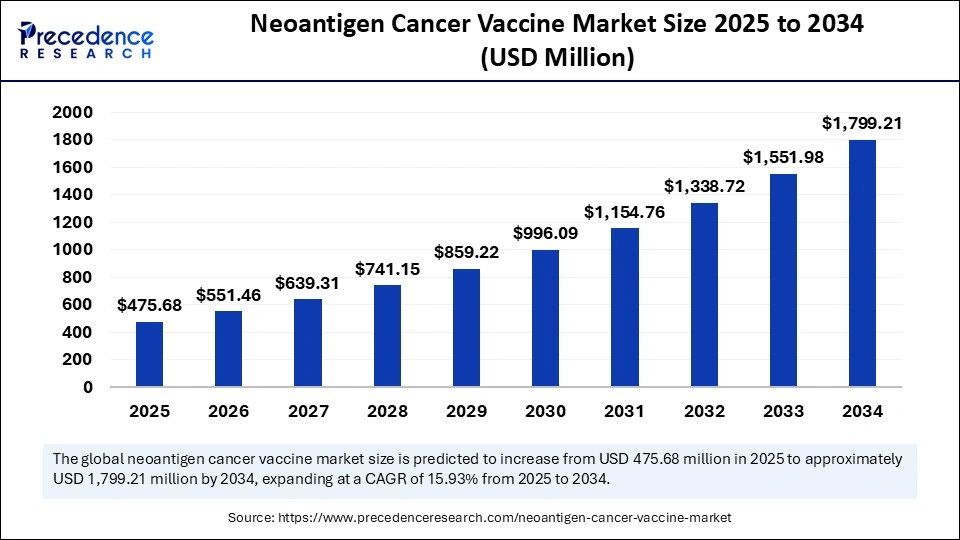
Market Highlights
- By region, North America held the largest market share of nearly 45% in 2024.
- The Asia Pacific is expected to grow at the fastest CAGR of 50% from 2025 to 2034.
- By product type, the personalized neoantigen vaccines segment held a 70% share of the market in 2024.
- By product type, the off-the-shelf neoantigen vaccines segment is growing at the fastest CAGR of 23.40% from 2025 to 2034.
- By neoantigen source, the tumor mutations segment held the largest market share of nearly 65% in 2024.
- By neoantigen source, the tumor-associated antigens segment is expected to grow at a significant CAGR of 30% from 2025 to 2034.
- By administration route, the intravenous segment held the largest market share of nearly 60% in 2024.
- By administration route, the intramuscular segment is expanding at a double-digit CAGR of 23.70% between 2025 and 2034.
- By technology platform, the mRNA-based vaccines segment held the largest market share of nearly 50% in 2024.
- By technology platform, the peptide-based segment is expected to expand at a significant CAGR of 35% from 2025 to 2034.
- By application, the melanoma segment held the largest market share of nearly 40% in 2024.
- By application, the NSCLC segment is growing at a solid CAGR of 30% from 2025 to 2034.
- By end-user, the biopharmaceutical companies segment held the largest market share of nearly 55% in 2024.
- By end user, the research institutions segment is expected to grow at the highest CAGR of 40% from 2025 to 2034.
Market Size and Forecast
- Market Size in 2025: USD 475.68 Million
- Market Size in 2026: USD 551.46 Million
- Forecasted Market Size by 2034: USD 1,799.21 Million
- CAGR (2025-2034): 15.93%
- Largest Market in 2024: North America
- Fastest Growing Market: Asia Pacific
What is Neoantigen Cancer Vaccine?
A neoantigen cancer vaccine is a personalized immunotherapy designed to stimulate the patient's immune system to target and destroy cancer cells. Neoantigens are unique proteins that arise from mutations in tumor cells and are not present in normal cells, making them ideal targets for cancer vaccines. The neoantigen cancer vaccine market focuses on developing personalized immunotherapies that utilize tumour-specific mutations (neoantigens) to create tailored vaccines. These vaccines aim to stimulate the patient's immune system to recognize and destroy cancer cells. This approach represents a significant advancement in precision oncology, offering the potential for more effective and less toxic cancer treatments.
How is AI Impacting the Neoantigen Cancer Vaccine Market?
AI is significantly transforming the market by enabling greater precision, speed, and personalization across the entire vaccine development pipeline. The integration of AI in the development of neoantigen cancer vaccines is delivering transformative results by accelerating every stage of the process, from identifying the most promising neoantigen candidates to optimizing vaccine design and delivery. As the demand for personalized, accurate, and rapid cancer treatment grows, AI has become a critical technology enabling this lifesaving approach.
AI models analyze complex genomic, transcriptomic, and proteomic data derived from a patient's tumor to pinpoint mutated peptides most likely to elicit a strong immune response. By incorporating factors such as MHC binding affinity, peptide stability, and T-cell receptor recognition, AI algorithms significantly enhance the precision and effectiveness of neoantigen-based therapies.
Neoantigen Cancer Vaccine Market Outlook
- Market Growth Overview: The market is experiencing rapid expansion driven by the increasing global cancer burden, which fuels demand for advanced and effective treatment modalities. Continuous advancements in next-generation sequencing (NGS), bioinformatics, and the integration of artificial intelligence in vaccine development, alongside breakthroughs in immunotherapy, are significantly propelling market growth.
- Focus on Manufacturing Optimization: There is a growing focus on optimizing manufacturing processes to enable more efficient and scalable production of personalized neoantigen vaccines. Innovations in vaccine delivery systems, including next-generation RNA platforms and advanced lipid nanoparticle technologies, are enhancing both stability and therapeutic efficacy.
- Global Expansion: While North America and Asia-Pacific remain the primary markets for neoantigen cancer vaccines, European countries such as the UK and Germany are making substantial contributions through robust R&D initiatives, collaborations, and government support aimed at meeting evolving healthcare needs.
Market Scope
| Report Coverage | Details |
| Market Size in 2025 | USD 475.68 Million |
| Market Size in 2026 | USD 551.46 Million |
| Market Size by 2034 | USD 1,799.21 Million |
| Market Growth Rate from 2025 to 2034 | CAGR of 15.93% |
| Dominating Region | North America |
| Fastest Growing Region | Asia Pacific |
| Base Year | 2025 |
| Forecast Period | 2025 to 2034 |
| Segments Covered | Product Type, Neoantigen Source, Administration Route, Technology Platform, Application, End-User, and Region |
| Regions Covered | North America, Europe, Asia-Pacific, Latin America, and Middle East & Africa |
Market Dynamics
Restraint
Tumor Heterogeneity
Despite its significant potential, the neoantigen cancer vaccine market faces a critical barrier in the form of tumor heterogeneity. Each cancer patient presents a unique genetic profile, leading to varying responses to treatment. A vaccine targeting a dominant tumor clone may be ineffective if resistant subclones persist, limiting therapeutic efficacy and posing challenges to broader market adoption.
Opportunity
Innovation Through Combination Therapies
The market holds strong growth potential, driven by advancements in clinical platforms and combination therapies. Combining neoantigen vaccines with immune checkpoint inhibitors has shown promising results, enhancing antitumor immune responses and improving outcomes in patients who may not respond to monotherapies. This synergistic approach opens new avenues for personalized and effective cancer treatments.
Segmental Insights
Product Type Insights
Which Product Contribute the Most Revenue Share in 2024?
The personalized neoantigen vaccines segment held about 70% share of the neoantigen cancer vaccine market in 2024. This is mainly due to their ability to target patient-specific tumor mutations without harming healthy cells. These vaccines demonstrate superior efficacy over conventional therapies by stimulating neoantigen-driven T-cell responses, which result in a more diversified immune attack and reduced off-target effects.
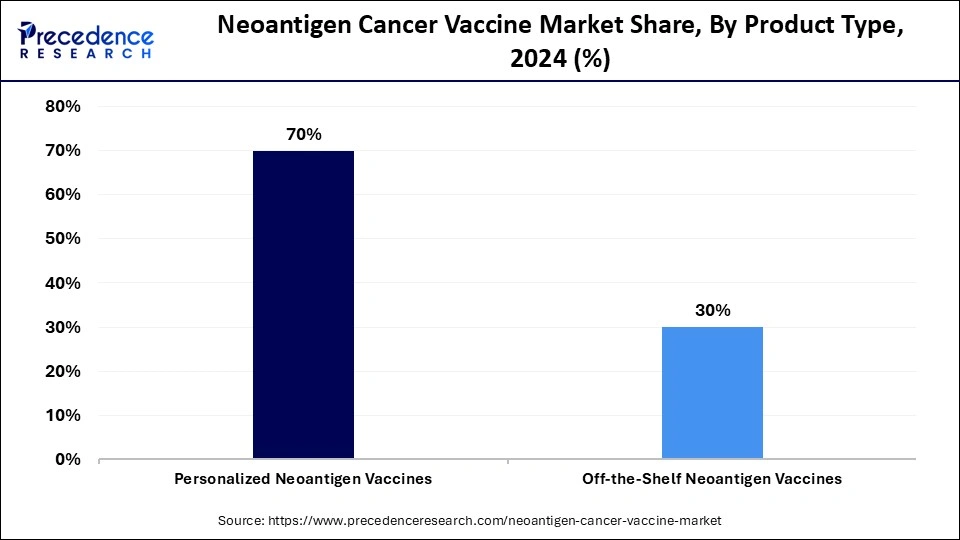
The off-the-shelf neoantigen vaccines segment is expected to grow at the fastest CAGR over the projection period. The growth of the segment is driven by their potential to offer a faster, cost-effective, and scalable alternative to personalized therapies. Technological advancements in mRNA platforms and next-generation sequencing have enabled the development of broad-spectrum neoantigen vaccines with high reliability and therapeutic promise.
Neoantigen Source Insights
Why Did the Tumor Mutations Segment Lead the Neoantigen Cancer Vaccine Market?
The tumor mutations segment led the market while holding nearly 65% share in 2024, owing to its ability to generate neoantigens that are highly unique and specific to an individual's cancer type. These mutations enable the development of personalized, targeted therapies with fewer side effects compared to conventional cancer treatments. Growth in this segment is further supported by advancements in genomics and bioinformatics, which have significantly improved therapeutic precision and patient outcomes.
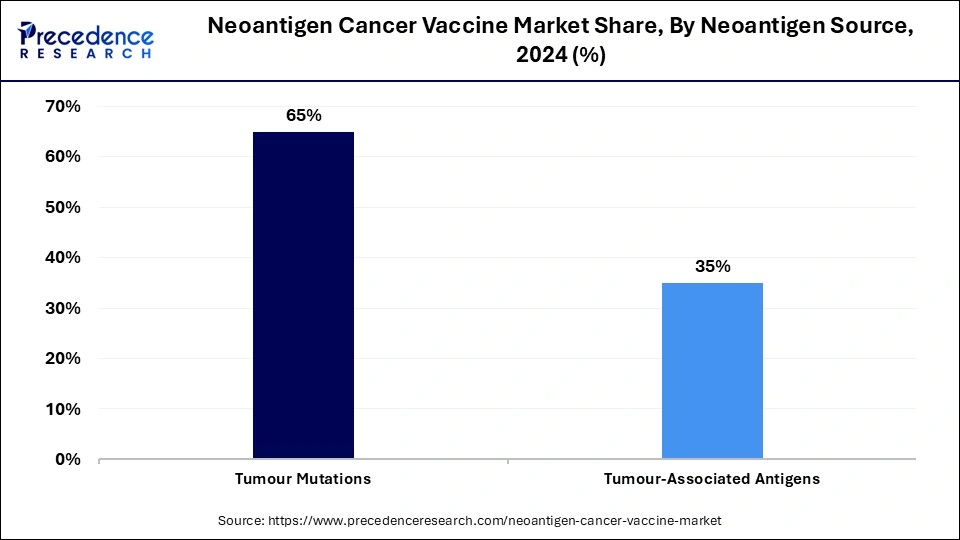
The tumor-associated antigens segment is expected to grow at a significant CAGR in the upcoming period. This growth is attributed to their utility in early cancer detection through biomarker identification, which aids in timely intervention. Additionally, these antigens provide a robust foundation for developing targeted immunotherapies that offer high specificity and minimal toxicity, making them attractive for future cancer treatment strategies.
Administration Route Insights
How Does the Intravenous Segment Dominate the Neoantigen Cancer Vaccine Market?
The intravenous segment dominated the market with approximately 60% share in 2024. The segment's dominance is attributed to its ability to provide rapid and precise distribution of the vaccine through the body which goes directly to the bloodstream and offers fast results. This route is especially preferred for complex formulations such as dendritic cell vaccines and nucleic acid-based therapies, which require high bioavailability and efficiency.
The intramuscular segment is expected to grow at the fastest rate in the foreseeable period. This growth is driven by the robust immune response it elicits, as well as its compatibility with mRNA-based platforms, which are central to next-generation vaccine technologies. Additionally, IM administration is widely regarded as a practical, safe, and minimally invasive method, further boosting its adoption.
Technology Platform Insights
Why Did the mRNA-Based Vaccines Lead the Neoantigen Cancer Vaccine Market?
The mRNA-based vaccines segment led the market, holding around 50% share in 2024. This dominance is driven by the platform's flexibility, rapid design, and scalable manufacturing capabilities, which are essential for creating personalized vaccines targeting specific tumor neoantigens. mRNA technology allows for the quick synthesis of diverse antigen sequences, enabling highly tailored treatments. Its cost-effectiveness, tolerability, and ability to stimulate strong immune responses further fuel its adoption.
The peptide-based segment is expected to grow at the highest CAGR during the forecast period. The growth of this segment is supported by its high precision in targeting tumor-specific antigens, a well-established manufacturing process, and customization potential. Compared to conventional therapies, peptide-based vaccines offer lower toxicity, improved safety profiles, and the ability to generate durable immune responses, making them a promising avenue for future cancer treatments.
Application Insights
What Made Melanoma the Dominant Segment in the Neoantigen Cancer Vaccine Market?
The melanoma segment dominated the market while holding the largest share of nearly 40% in 2024. This is due to melanoma's high tumor mutational burden (TMB), which generates numerous cancer-specific antigens that neoantigen vaccines can effectively target. Positive clinical trials, even in advanced melanoma stages, have demonstrated the feasibility and promising efficacy of personalized vaccines. Additionally, the high TMB in melanoma closely aligns with animal models used in preclinical studies, making it a preferred tumor type for testing vaccine efficacy.
The NSCLC segment is expected to grow at the fastest CAGR in the coming years. This growth is fueled by the high incidence and mortality rates of lung cancer, particularly NSCLC, creating a strong demand for more effective treatments such as neoantigen vaccines. The ability of these vaccines to specifically target cancer cells while sparing healthy tissues further boosted their use in NSCLC.
End-User Insights
Why Did the Biopharmaceutical Companies Segment Dominate the Neoantigen Cancer Vaccine Market?
The biopharmaceutical companies segment held the largest market share of nearly 55% in 2024. This dominance is driven by their substantial investments in research and development, collaborations with academic institutions, and established expertise in clinical trials and drug manufacturing. Additionally, significant public and private funding dedicated to neoantigen research further strengthens this segment's leading position.
The research institutions segment is expected to grow at the fastest rate in the foreseeable period. This growth is fueled by increasing investments in personalized cancer treatment research, driven by rising cancer incidence and its severe impact. Research institutions are also leveraging cutting-edge technologies, such as AI, to accelerate experimentation and achieve promising results.
Regional Insights
U.S. Neoantigen Cancer Vaccine Market Size and Growth 2025 to 2034
The U.S. neoantigen cancer vaccine market size is exhibited at USD 171.24 million in 2025 and is projected to be worth around USD 659.21 million by 2034, growing at a CAGR of 16.13% from 2025 to 2034.
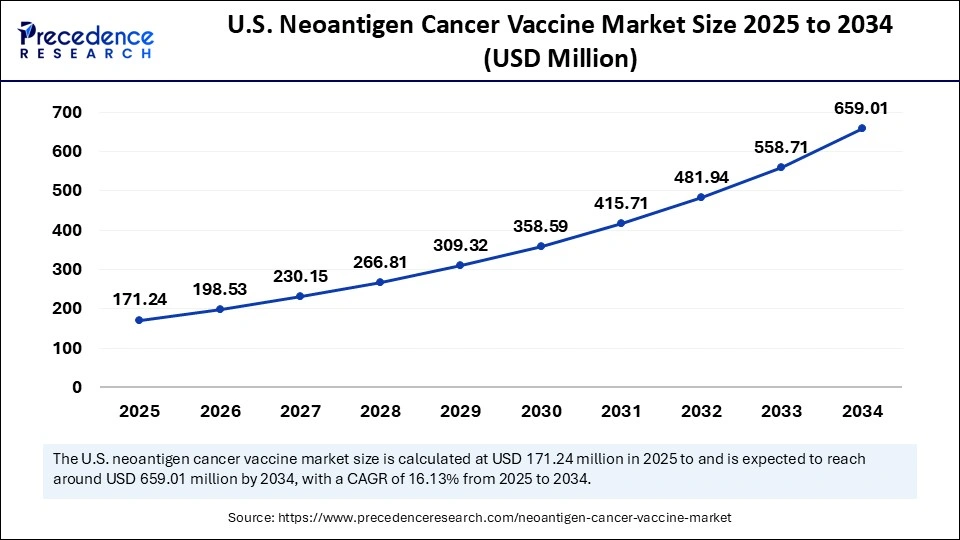
What Made North America the Dominant Region in the Neoantigen Cancer Vaccine Market?
North America dominated the market by capturing nearly 45% share in 2024. This dominance is attributed to robust funding for research and development in anti-cancer therapies, alongside advanced infrastructure supporting neoantigen cancer vaccine research. Leading advancements in next-generation sequencing and bioinformatics, particularly in North America, are critical for the precise identification of patient-specific neoantigens.
The region also benefits from high awareness and a mature healthcare system capable of early disease detection and advanced oncology treatments such as immunotherapies. This environment ensures strong market receptivity to new neoantigen vaccines once they receive regulatory approval.
How Does the U.S. Contribute to North America's Neoantigen Cancer Vaccine Market?
The U.S. serves as a hub for both established pharmaceutical giants and innovative biotech startups driving the development of personalized immunotherapies. Access to cutting-edge genomics and bioinformatics tools further accelerates market growth. The U.S. leads in mRNA technology, a promising platform for neoantigen vaccine development. Additionally, companies like Merck & Co. are investing heavily in neoantigen vaccine R&D, often through collaborations with biotech firms. The U.S. FDA's supportive stance towards innovative cancer treatments also facilitates faster approvals and market entry.
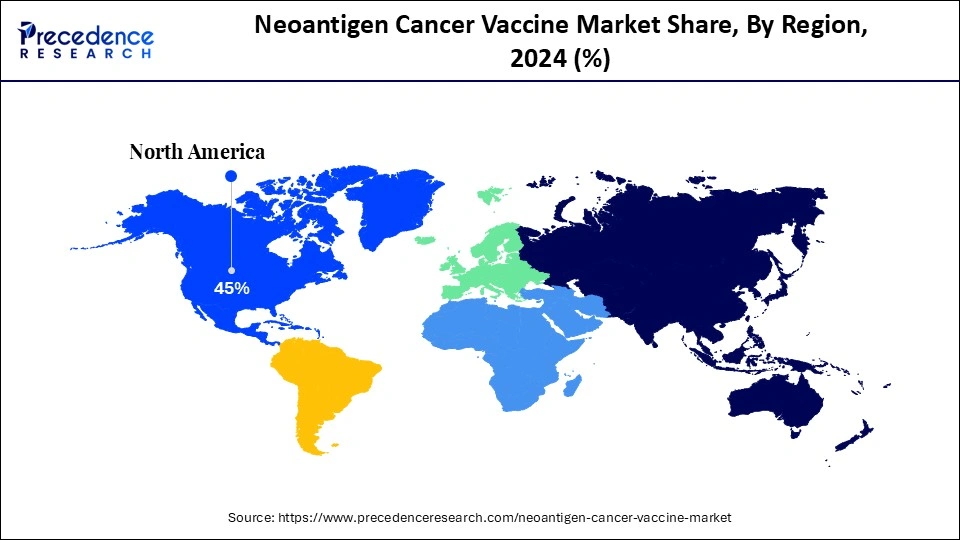
What Factors Support Growth of the Asia Pacific Neoantigen Cancer Vaccine Market?
Asia Pacific is expected to grow at the fastest CAGR in the foreseeable period. The regional market growth is driven by demographic shifts, notably an aging population that is more susceptible to fatal diseases such as cancer. The region accounts for nearly 60% of global cancer cases, prompting increased healthcare investments by leading countries as a strategic response. Additionally, national initiatives and collaborations between local biotech firms are further fueling market growth.
Why Is China Considered a Leader in the Neoantigen Cancer Vaccine Market in Asia?
China plays a pivotal role in the region's neoantigen cancer vaccine market growth through strong collaboration between domestic biotech companies and government initiatives like “Healthy China 2030.” The country's regulatory body, the National Medical Products Administration (NMPA), has become increasingly receptive to innovative cancer therapies, accelerating approvals and encouraging market expansion.
Value Chain Analysis of Neoantigen Cancer Vaccine Market
- Neoantigen Identification & Discovery: This initial stage focuses on identifying unique tumor-specific antigens (neoantigens) by analyzing a patient's tumor genomics using advanced sequencing technologies and bioinformatics tools.
- Vaccine Design & Development: At this stage, the identified neoantigens are used to design vaccine candidates tailored to elicit a targeted immune response. Sophisticated computational models and AI are employed to optimize vaccine constructs, enhancing specificity and potency while minimizing off-target effects.
- Clinical Trials: This phase involves multi-stage human testing (Phase I-III) to assess vaccine safety, dosage, and therapeutic effectiveness across diverse patient populations.
- Regulatory Approval: Regulatory bodies evaluate comprehensive clinical data to grant approval for vaccine commercialization. Personalized vaccines present unique regulatory challenges, necessitating adaptive approval frameworks that balance innovation with safety and efficacy standards.
- Distribution & Commercialization: After approval, vaccines are distributed through cold-chain logistics to healthcare facilities, ensuring stability and potency upon delivery. Effective commercialization strategies, including collaborations with healthcare providers and awareness campaigns, are vital to drive adoption and patient access.
Top Companies in the Neoantigen Cancer Vaccine Market & their Offerings
Tier I: Market Leaders
These companies dominate the neoantigen cancer vaccine market with strong global presence, significant R&D investment, advanced clinical pipelines, and strategic collaborations driving major revenue shares.
| Company | Contribution & Role |
| Moderna Inc | Leading mRNA neoantigen vaccine developer, contributing a significant portion of market revenue through rapid vaccine design and manufacturing |
| BioNTech SE | Major player with personalized vaccine platforms and extensive partnerships, holding a large market share driven by successful clinical advancements. |
| Merck & Co., Inc. | Significant contributor via collaborative neoantigen vaccine development and extensive oncology portfolio. |
| F. Hoffmann-La Roche Ltd. | Strong presence due to investments in personalized cancer immunotherapies and joint ventures with biotech innovators. |
| Gritstone bio, Inc. | Important contributor leveraging EDGE platform for personalized vaccines, boosting market revenue. |
Tier II: Established Players
These companies hold substantial revenue shares through focused development of neoantigen vaccine technologies, strong pipelines, and collaborations enhancing market footprint.
| Company | Contribution & Role |
| OSE Immunotherapeutics SA | Rising revenue contribution via targeted neoantigen vaccine candidates and growing clinical trials. |
| Advaxis, Inc. | Notable market share from innovative Listeria-based cancer vaccines and partnerships. |
| Agenus Inc. | Consistent revenue from neoantigen-based immunotherapy research and development efforts. |
| Vaccibody AS | Growing presence driven by DNA-based personalized vaccine platforms, expanding clinical pipelines. |
| Novogene Co., Ltd. | Significant service provider for genomic sequencing, supporting neoantigen identification fueling vaccine design. |
Tier III: Emerging and Niche Players
These smaller or specialized companies contribute through innovative approaches, niche technologies, or regional strengths, gradually increasing their market presence.
| Company | Contribution & Role |
| Immunocore Limited | Emerging contributor focusing on T-cell engager therapies targeting neoantigens, enhancing niche market share. |
| Poseida Therapeutics, Inc | Small but growing revenue share via gene editing and personalized cancer vaccine platforms. |
| Precision BioSciences, Inc. | Niche player with gene-edited T-cell therapies contributing to neoantigen vaccine pipeline. |
| Inovio Pharmaceuticals, Inc. | Early-stage neoantigen vaccine developer contributing through DNA vaccine innovation. |
| Axsome Therapeutics, Inc | Limited but expanding presence exploring neoantigen immunotherapies in oncology pipeline. |
Recent Developments
- In February 2025, a Phase 1 study published in the renowned science journal Nature indicates that personalized neo-antigen vaccines generated responses that are anti-cancer immune in all nine patients. It shows a fully resected clear cell renal cell carcinoma, and no recurrence is observed.
(Source: https://www.nature.com) - In November 2024, Transgene, a leading biotech company that designs and develops virus–based immunotherapies to treat various types of cancer, introduced TG4050, an individualized immunotherapy developed for solid tumors. It has not shown any relapses after being injected.
(Source: https://www.nec.com)
Expert Analysis
The neoantigen cancer vaccine market is poised for exponential growth, underpinned by a confluence of technological advancements, expanding oncology pipelines, and increasing demand for personalized immunotherapies. The market's potential is significantly catalyzed by the advent of high-throughput next-generation sequencing (NGS) and sophisticated bioinformatics algorithms that enable the rapid identification of patient-specific neoantigens, thereby facilitating the development of highly tailored vaccine candidates with enhanced efficacy and safety profiles. Additionally, the integration of artificial intelligence (AI) in neoantigen prediction and vaccine design processes is set to streamline R&D timelines, reduce attrition rates, and augment therapeutic precision, positioning the market at the forefront of precision oncology.
Strategic collaborations between biotech innovators, academic institutions, and pharmaceutical conglomerates are accelerating translational research, enabling expedited clinical validation and regulatory approvals. Furthermore, the increasing prevalence of cancers with high tumor mutational burdens (TMB), such as melanoma and non-small cell lung cancer (NSCLC), presents a fertile landscape for neoantigen vaccine application, thereby broadening the addressable patient population. The rising incidence of cancer globally, particularly in emerging markets with expanding healthcare infrastructure, presents untapped opportunities for market penetration and revenue diversification.
Notably, the shift toward combination therapies, integrating neoantigen vaccines with immune checkpoint inhibitors and adoptive cell therapies, heralds a paradigm shift in oncological treatment modalities, enhancing antitumor immune responses and improving patient outcomes. However, market participants must navigate complex regulatory frameworks, manufacturing scalability challenges, and tumor heterogeneity to fully capitalize on growth prospects. Overall, the neoantigen cancer vaccine market epitomizes a high-growth segment within biopharmaceuticals, offering compelling opportunities for innovation-driven revenue expansion and long-term value creation.
Segments Covered in the Report
By Product Type
- Personalized Neoantigen Vaccines
- Off-the-Shelf Neoantigen Vaccines
By Neoantigen Source
- Tumour Mutations
- Tumour-Associated Antigens
By Administration Route
- Intravenous
- Intramuscular
- Transdermal
- Others
By Technology Platform
- mRNA-Based Vaccines
- Peptide-Based Vaccines
- Viral Vector-Based Vaccines
- Others
By Application
- Melanoma
- Non-Small Cell Lung Cancer (NSCLC)
- Pancreatic Cancer
- Others
By End-User
- Biopharmaceutical Companies
- Research Institutions
- Hospitals and Clinics
By Region
- North America
- Europe
- Asia-Pacific
- Latin America
- Middle East & Africa
For inquiries regarding discounts, bulk purchases, or customization requests, please contact us at sales@precedenceresearch.com
Frequently Asked Questions
Ask For Sample
No cookie-cutter, only authentic analysis – take the 1st step to become a Precedence Research client